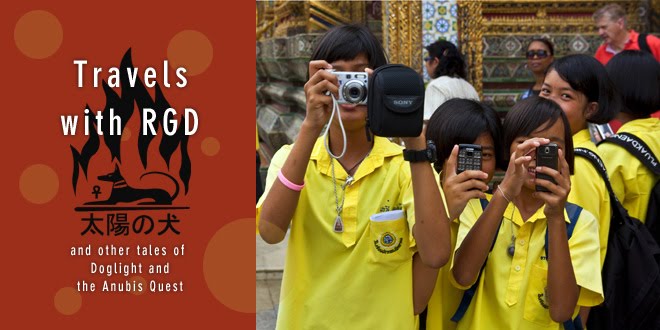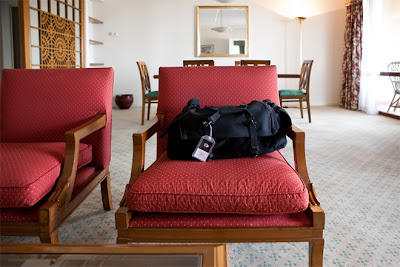My second-to-last day in Cairo broke bright and hot. I'd slept in a little later than usual, as I was in no hurry to get started. The Antiquities Office didn't open until 9 a.m., and I knew that most of the people there didn't want to receive visitors until after they'd had their morning tea, so I figured 9:30 was a safe bet. I had a delicious breakfast of Twinkies and Diet Coke, then turned on the news to see if there was anything new with the volcano.
A little after nine, Magdy and I made the obligatory trip across the Nile to Dr. Hawass's office. As agreed, Magdy circled the block, while I took the stairs two at a time up to the second floor. There, I found the gentlemen who were in charge of my permissions and made sure to find out who at the museum knew I was coming. I was handed a slip of paper with my museum contact's name written in Arabic and was told "no problem, if God is willing."
My contact, Mr. Abdeen, would be responsible for getting me and my cameras inside with as little hassle as possible. A couple of years ago, because visitors didn’t have the ability to turn off their camera's flash, Dr. Hawass was forced to prohibit cameras all together. Now, photographers must be accompanied by a staff member at all times during their working sessions.
Side Note: Located next to the museum, the Nile Hilton is, or used to be, my favorite hotel in all of Cairo. It is a mid-century architectural masterpiece / landmark that has fallen on hard times. I've stayed there several times in the past, and even in its elegant shabbiness, its patisseries and restaurants were the preferred rendezvous spot for many of Cairo's movers and shakers. Last year, I noticed that all of a sudden, the Hilton name was missing from the front of the hotel. Upon inquiry, I found that the Hilton Worldwide chain had sold the place. It was open for a while as the Nile Hotel. Now, the place is completely closed and undergoing a major renovation. When it reopens, it will be part of the Ritz-Carlton hotel chain. I am eager to see if any of the old mystique remains, but still, the name Nile Hilton will live on in the romantic memories of many past patrons, including myself.
Every day, busloads of tourists from Red Sea resorts (a six-hour ride each way) are dropped off in front of Egypt's holy of holies, The Museum of Egyptian Antiquities, known commonly as the Egyptian Museum, for a two-hour visit. If you're unlucky enough that your arrival coincides with theirs, you can expect a very long security process. This was the case when I pulled up. Two giant behemoths were disgorging their Russian-speaking passengers into the museum's already bulging queue. I just laughed the laugh of the experienced traveler and said what the hell, and went to the back of the line. By the time I'd got through security, the back of my shirt was soaked through.
I stood in the courtyard surveying the faded oxblood neoclassical facade. Built in 1891, the museum has three front entrances: the main (center) entrance is for paying visitors, the left is the entrance to the museum's library, and the one on the right leads to the museum's administration section, which is the one I headed for. This is the entrance for employees and official guests. I identified myself at the guard station and asked for direction to Mr. Abdeen’s office. Like most Egyptian offices, it was full to overflowing with visitors. I waited my turn, then introduced myself to Mr. Abdeen. He invited me to have tea. I didn’t refuse; this is part of the Egyptian ritual of hospitality, and you never want to be viewed as impolite. I cleared away a space, sat down, and accepted the boiling-hot glass of tea. This is the normal way tea is served here, in a clear, small glass, usually emblazoned with the Lipton Tea logo. Once I'd slurped down the contents of my glass, he summoned the young woman who was charged with expediting my visit. Ms. Sayed was in her early 20s, attractive even in her demure Islamic dress.
To get from the administration section into the museum proper, you have to go through another security checkpoint. The guards made a thorough inspection of me and my camera bag to make sure I wasn't bringing in any weapons or illicit contraband. I knew from past experience that they'd be twice as thorough on the way out, making sure I wasn't leaving with more than I came in with.
Ms. Sayed led the way across the museum through flocks of color-coded tourists to the southwest corner, where the Old Kingdom relics are housed. This section is dominated by the descendants of Snefru (in my opinion the greatest Egyptian king). He was the father of Khufu, grandfather to Khafra, and great-grandfather to Menkaure. His bloodline's monuments have defined the world's vision of Egypt for the past four thousand years.
On the ground floor, in Hall 42, is the famous life-size diorite statue of the Pharaoh Khafra. This statue of the owner of the second-largest pyramid at Giza was rediscovered by Marietta under the floor in the Valley Temple of Khafre in 1860. This well-polished piece of perfection is the embodiment of the state’s concept of strength, power, and grace — what every good pharaoh should be. I set up my tripod and began to shoot away, while Ms. Sayed stood in the shadows, making sure that I didn't transgress any of the museum's regulations. I spent the next couple of hours looking for and photographing some of the Old Kingdom’s most iconic artifacts, including statues of Ranofer, high priest of Ptah and Sokar, and Prince Rahotep and his wife Nofret, and a painted plaster fragment from their tomb.
It's a little bit weird shooting here now. Since no one outside of professionals are allowed to shoot inside the museum anymore, all the tourist groups stare at you, because you might be someone famous. This can become somewhat uncomfortable, especially when they hover for long periods of time.
From the Old Kingdom, we climbed the stairs to the second floor to find the masks of Yuya. I took a while to line up my shot so as to not get any reflection from the glass case it was displayed in. I tried my polarizing filter, but it dulled the mask too much, so I just kept changing positions until I had what I wanted. I also grabbed a couple of shots of some beautiful wooden ushabti, then headed back down to shoot a couple of Old Kingdom sarcophagi very near the checkpoint to leave the museum. After the last shot, we moved over to the secure exit and stood there a while the guards did their duty, then they smiled and passed us on. I said goodbye to Ms. Sayed and headed out into the courtyard.
I sat down for a couple of minutes, collecting my thoughts and putting most of my camera gear away while I watched the tourists filing in. Tourism is Egypt’s main source of foreign currency, and without it the state would be very hard-pressed to continue. That's why most Egyptians cherish visitors, even the ones who arrive with a "light purse." I gave Magdy a buzz, and he said to give him ten minutes. Out front, I watched the buses reload and head out with dazed passengers. The Pyramids would be the next stop for these weary travelers, who'd been riding since before midnight to make this journey of homage to ancient Egypt and travel promotions.
From the museum, we headed to Zamalek. I love the island (Zamalek). It's where most of the foreign embassies are located and where most of their staff reside. It has a very European feel, with an exotic twist that is almost intoxicating. Several years ago, I'd stayed in a friend’s flat at 25 Ahmed Hashmet Street. I was only there a few weeks, but it was a very memorable experience. Magdy found a tentative place to park, and I made my way down to Cafe Tabasco for a late lunch. I selected a table and ordered a tuna sandwich. The cafe has changed a lot over the past year, and has much more of an internet cafe feel now. They have WiFi now, no more dragging out of long land lines to connect to the internet. I finished my sandwich and walked to the Saudi Store to get a few snacks for the plane. After that, I walked around a little to soak in the ambiance. This is a high-end section of Cairo, with some upscale shops that have fabulous window displays. I snapped a couple of photographs, but the area is so densely populated with people that it's hard to get enough clear space for a good shot. I found my way back to the car, where Magdy was soothing the person in charge of the space. I tipped him and everything was fine. It was late afternoon, so I we headed back to the Hilton. I needed to relax and write in my journal, and try to decide what to do tomorrow, and begin to pack.
I asked Magdy if he wanted to settle the car rental that evening. He thought this might be a good idea, since that way we wouldn't have to deal with it tomorrow. He parked out front of the Hilton while I ran upstairs to get some cash. I dumped my bags, went to the safe and worked the combo, then counted out five one-hundred-dollar bills. I thought it was a fair deal for the 10-day rental, especially since we had gone outside the city limits to Tuna Gebel. I grabbed my 5D and took the elevator down. Magdy smiled at the greenbacks, and I waved as the guards lowered the chains and he drove out.
I stopped on the fifth floor, went out to the terrace café, and ordered a lemon drink. I sat there staring out at the sun setting over the Nile with a little sadness, knowing that I wasn't sure I'd ever be back.
Around 8 I ordered my usual spaghetti and had a leisurely dinner out on the patio watching the lights of Cairo. There's something about the feel of the night here that's like the decaying elegance of a past gone forever. It lingers in the mind long after you've moved on.































Shots from the museum are better than in my art books. My favorite in this set is the bag on the chair, it feels timeless.
ReplyDelete